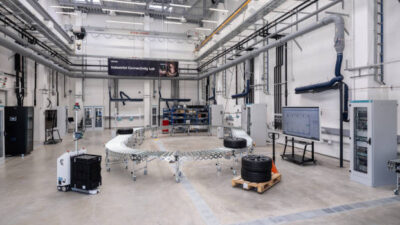Control and monitoring software upgrades existing machine tools easily, while a new wireless link supports two-way communications.
|
|
The original system had rotating antenna and a static receiver. the new system uses Bluetooth wireless communications. Source: Sigmapi Systems Ltd.
|
Industrial use of friction stir welding (FSW) has been limited to those industry sectors that have sufficient capital to invest in the technology. Lowstir technology, however, converts an existing milling machine into a friction stir welder, and a new wireless link supports two-way communications via Bluetooth.
Friction stir welding (FSW), invented by The Welding Institute (TWI) in 1991, involves a spinning tool and downward force to create frictional heat that causes material to create a weld. Most current uses involve the joining of aluminium alloys, for applications including aircraft components, automotive components, pressure vessels, and more. FSW also has been applied to the joining of magnesium, copper, steels, and titanium alloys. But industrial use of FSW has been limited to those industry sectors with sufficient capital to invest in its high technology costs.
Sigmapi Systems Limited worked with TWI, Applied Measurements Ltd., Suffolk Precision Ltd. and Fatronik to produce Lowstir, which uses a normal milling machine for its control rather than traditional capital intensive electro-mechanical control systems. Lowstir also automatically monitors the process through an easy-to-use operator interface to provide feedback on the quality of the weld produced. (Standard milling machines lack the process monitoring capabilities required to ensure high-quality friction-stir-welded joints.)
LOSTIR (no ‘w’) was the original project that developed a low cost FSW monitoring system retrofittable to milling machines. It uses a custom-made sensing head incorporating the tool holder, electronics, a ceramic heat shield, and a rotating antenna for transmission of the data to a stationary receiver, mounted onto the frame of the machine. The receiver is connected via cables to a signal processing module, computer and mains power supply. While this system has been used successfully since 2005, the use of telemetry for the signal transmission means an antenna and receiver arrangement is necessary to complete cable connections.
Wireless communications arrives
Sigmapi Systems and Applied Measurements recently produced LowStir Mk 2, a wireless version of the original model that provides users with significant benefits. “The ability to go wireless is a huge leap over the previous technology,” says Andy Westcott of BAE Systems. Not having to worry about trailing cables to the laptop reduces set up time and makes measurements during welding very straightforward, he adds.
To ensure the forces from the welding process do not affect the electronics, and to gain the benefit of a wireless system, the sensor head was modified to use a battery power supply and a Bluetooth connection to transmit machining data to a stationery receiver, such as a notebook computer fitted with a standard Bluetooth module.
This modification means that the sensitive electronics and rotating antenna for the telemetry transmission is no longer required, nor are the stationery receiver or the signal processing unit, power supply or associated trailing cables. The original design has been considerably revised to accommodate these changes, resulting in a reduction in the size of the sensor head, making it both lighter and stiffer.
The Bluetooth ‘switch’ is a simple jack-plug arrangement, pull out the plug and the Lowstir device will ‘search’ for the laptop. Once finished, simply replace the plug– that’s all there is to it. Also as the power supply is now built-in using a rechargeable battery, it makes it a very versatile system. What was once a highly specialised measurement using equipment costing many hundreds of thousands of pounds, is now a relatively inexpensive process usingequipment available in most engineering workshops, all driven by easy to use software.
|
This flow diagram shows the temperature distribution within the welding head after 60 minutes of ooperation. Used with permission of TWI Ltd.
|
A weld monitoring system has been developed to accurately measure the vertical and horizontal forces and torque on the tool. The sensor is machined from one piece of high grade stainless steel, heat treated for maximum strength and stability. The sensor design allows for various taper sizes to be attached to accommodate the requirements of the user. The data gathered can be directly linked to the acceptance or otherwise of the weld. In addition, the device has the capability to monitor two user defined temperatures via thermocouples, one to be attached to the FSW tool, the second will serve as a safety cut out to protect the integral telemetry circuit, monitoring the temperature at the interface between the tool holder and the weld monitoring system.
The information gathered by the Lowstir device is displayed to the operator using a notebook PC running NI LabView. The instrument panel displays real time numerical values of forces, torque, the temperature adjacent to the system electronics and (if desired) the tool temperature. The system also has the capability to add real-time event markers to allow correlation between process conditions/stages and the recorded data. The main display screen has buttons to start and stop recording of data. Alternatively an automatic trigger facility exists for initiating the recording of data.
The display also shows the current captured data values for the weld in progress and indicates whether they are within the acceptable range for satisfactory welding. The display also has a multi-graph facility where the user can select which sensor values are displayed.
| Author Information |
| Susan Jones is managing director of Sigmapi Systems Ltd. Reach her at [email protected] . |



